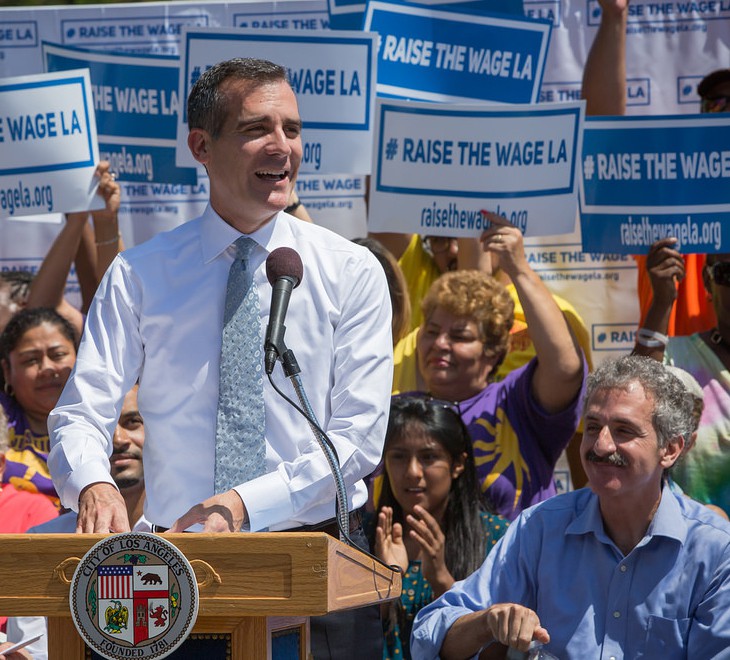Homeless in LA is a report commissioned by the Los Angeles Homeless Services Authority as part of its strategic planning process for Bring LA Home: The Ten Year Plan to End Homelessness in Los Angeles. Begun in 2003, Bring LA home is developing consensus and community input on the best way for ending homelessness in Los Angeles, and mobilizing the political resources and will to accomplish the goal.
Los Angeles’ rate of homelessness is higher than the U.S. average because it has a higher rate of poverty and higher housing costs. Compared to the U.S., a disproportionately large share of homeless residents lives on the streets. This report maps the size and characteristics of this population, and will be merged with information from community meetings held throughout the county to produce a 10-year strategic plan for ending homelessness. By integrating a series of data sets that provide partial information about the homeless population, this report produces estimates of the number of people who were homeless in the county on a given day in 2002, the duration of their homelessness, and the total annual homeless population. There is substantial uncertainty about these estimates, but they are among the most current and up-to-date given the limited data available on homeless individuals and families.
Most people escape homelessness through income from employment or public benefits, or a combination of the two, that enables them to obtain housing. The solution to homelessness lies in helping more people secure a sustainable income, and in helping those who are unable to secure an income to obtain housing. Key findings for planning a strategy to end homelessness include:
Where and How People Become Homeless
- Los Angeles has become a seedbed of homelessness for other regions, sending out one and one-half times as many homeless people as it receives.
- People become homeless more easily in some parts of the county than others. Homeless public assistance recipients are equivalent to 34 percent of the poverty population in the Antelope Valley, 23 percent in South Los Angeles, and 9 percent in the rest of the county.
- Drugs and alcohol are the most frequently reported causes of homelessness.
- Sixty percent of homeless single adults and 53 percent of families come into Winter Shelter after having been in the care of another organization. Better post-release planning and advocacy would reduce homelessness.
- A large wave of homelessness, particularly among families, appears to emerge at the beginning of the year.
- Homelessness lasts less than a year for 95 percent of those who are homeless.
Demographic Profile
- Homeless residents are younger than the overall population. Many are children under 5 and young mothers 18 to 29 years of age.
- African Americans are over-represented by a factor of 5 in the county’s homeless population. All other ethnic groups are under-represented.
- Seventeen percent of homeless adults report a history of active military service. This is nearly double the 9 percent rate for the rest of the county.
- Fourteen percent of single homeless adults who remained in Los Angeles gained access to subsidized public housing over an 8-year period.
- Forty-two percent of homeless residents report some type of disability – double the disability rate for the county.
- Eighty-six percent of homeless adults are citizens, compared to 71 percent of the county’s overall working age population.
- Homeless residents are 50 percent more likely to lack a high school diploma and 50 percent less likely to have attended college than the overall county.
Homelessness And Public Assistance
- Eighty-five percent of homeless receive some form of county public assistance.
- Two-thirds of homeless welfare recipients are in families, one-third are single.
- Two-thirds of homeless families have had a recent break in welfare benefits.
Connections to Work and Sustainable Earnings
- Two-thirds of homeless public assistance recipients are working age adults.
- The most frequent source of income before the onset of homelessness is a job.
- Temporary Unemployment and Disability insurance benefits appear to replace employment income for many people after they become homeless.
- Most homeless adults have histories of work, but not of sustainable earnings.
- Only 29 percent of homeless workers earned sustainable wages (150 percent or more of the poverty threshold) in the year prior to homelessness.
- Homeless adults are 40 percent more likely to be out of the labor force, and the unemployment rate of those in the labor force is 6 times the county rate.
- Homeless workers are concentrated in the lowest-paying occupations, many of which do not offer prospects for advancement to a sustainable wage.
- Many homeless workers hold jobs offering only part-time, intermittent work.
- Workers with low earnings are handicapped both by their lack of income and the especially unpredictability nature of their income.
- With more intensive and effective training and supportive services, 35 to 38 percent of homeless adults might become self-sufficient through work.
Costs and Resources to End Homelessness
- It is not financially feasible to end homelessness unless the flow of new entrants into homelessness is curtailed dramatically.
- Local jurisdictions spend an estimated $404 million annually on homeless services and housing, with an additional $115 million in private outlays.
- More effective efforts to help homeless residents re-enter the labor force and obtain public benefits will reduce costs by an estimated16 percent.
- Reducing the flow of people being cared for by major social institutions into homelessness will reduce costs by an estimated 47 percent.
- Providing housing is by far the greatest cost in ending homelessness – accounting for two-thirds to three-quarters of total costs.
- Even with highly effective strategies it will be necessary to take additional steps to improve how resources are used and to bring in new resources.
- Current expenditures already equal 35 to 59 percent (depending on the year) of the estimated annual cost of an effective strategy to end homelessness over the next ten years. With full participation of all local, state and national stakeholders there are adequate resources to end homelessness in 10 years.
This report brings together the Economic Roundtable’s research for “Bring LA Home,” a strategic planning initiative to end homelessness in Los Angeles County. It expands and completes a preliminary report that was released in November 2003. New material included in this final report is listed at the end of Chapter 2.
Chapter Headings
- Executive Summary
- Strategic Information About Homelessness
- Where, Why and How Long People Are Homeless
- Institutional Linkages and Population Dynamics
- Demographic Characteristics
- Escaping Homelessness Through Work
- How Many People are Homeless
- Scope of Services and Cost to End Homelessness
- Local Outlays for Homeless Residents
- Findings
- Data Sources and Limitations
- Comments by the Department of Public Social Services













